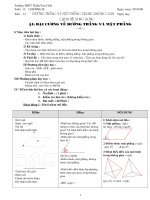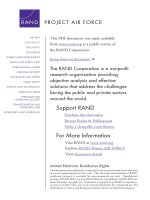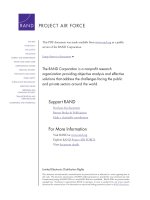Thinking About America’s Defense - An Analytical Memoir pptx
Bạn đang xem bản rút gọn của tài liệu. Xem và tải ngay bản đầy đủ của tài liệu tại đây (1.4 MB, 283 trang )
This document and trademark(s) contained herein are protected by law as indicated
in a notice appearing later in this work. This electronic representation of RAND
intellectual property is provided for non-commercial use only. Unauthorized
posting of RAND PDFs to a non-RAND Web site is prohibited. RAND PDFs are
protected under copyright law. Permission is required from RAND to reproduce,
or reuse in another form, any of our research documents for commercial use. For
information on reprint and linking permissions, please see RAND Permissions.
Limited Electronic Distribution Rights
Visit RAND at www.rand.org
Explore RAND Project AIR FORCE
View document details
For More Information
This PDF document was made available
from www.rand.org as a public service of
the RAND Corporation.
6
Jump down to document
THE ARTS
CHILD POLICY
CIVIL JUSTICE
EDUCATION
ENERGY AND ENVIRONMENT
HEALTH AND HEALTH CARE
INTERNATIONAL AFFAIRS
NATIONAL SECURITY
POPULATION AND AGING
PUBLIC SAFETY
SCIENCE AND TECHNOLOGY
SUBSTANCE ABUSE
TERRORISM AND
HOMELAND SECURITY
TRANSPORTATION AND
INFRASTRUCTURE
WORKFORCE AND WORKPLACE
The RAND Corporation is a nonprofit
research organization providing
objective analysis and effective
solutions that address the challenges
facing the public and private sectors
around the world.
Purchase this document
Browse Books & Publications
Make a charitable contribution
Support RAND
This product is part of the RAND Corporation occasional paper series.
RAND occasional papers may include an informed perspective on a
timely policy issue, a discussion of new research methodologies, essays,
a paper presented at a conference, a conference summary, or a summa-
ry of work in progress. All RAND occasional papers undergo rigorous
peer review to ensure that they meet high standards for research quality
and objectivity.
Prepared for the United States Air Force
Approved for public release; distribution unlimited
PROJECT AIR FORCE
Glenn A. Kent
THINKING
ABOUT
AMERICA’S
DEFENSE
An Analytical Memoir
With
David Ochmanek
Michael Spirtas
Bruce R. Pirnie
The RAND Corporation is a nonprofit research organization providing
objective analysis and effective solutions that address the challenges
facing the public and private sectors around the world. RAND’s
publications do not necessarily reflect the opinions of its research clients
and sponsors.
R
®
is a registered trademark.
© Copyright 2008 RAND Corporation
All rights reserved. No part of this book may be reproduced in any
form by any electronic or mechanical means (including photocopying,
recording, or information storage and retrieval) without permission in
writing from RAND.
Published 2008 by the RAND Corporation
1776 Main Street, P.O. Box 2138, Santa Monica, CA 90407-2138
1200 South Hayes Street, Arlington, VA 22202-5050
4570 Fifth Avenue, Suite 600, Pittsburgh, PA 15213-2665
RAND URL:
To order RAND documents or to obtain additional information, contact
Distribution Services: Telephone: (310) 451-7002;
Fax: (310) 451-6915; Email:
Cover design by Carol Earnest
This publication was sponsored by the United States Air Force under
Contract FA7014-06-C-0001. Further information may be obtained
from the Strategic Planning Division, Directorate of Plans, Hq USAF.
Library of Congress Cataloging-in-Publication Data
Kent, Glenn A., 1915–
Thinking about America’s defense : an analytical memoir / Glenn A. Kent ; with
David Ochmanek, Michael Spirtas, Bruce R. Pirnie.
p. cm.
Includes bibliographical references.
ISBN 978-0-8330-4452-5 (pbk. : alk. paper)
1. Military planning—United States. 2. United States. Air Force—Officers—
Biography. 3. Generals—United States—Biography. 4. Strategic forces—United
States. 5. National security—United States. 6. United States—Defenses—Decision
making. 7. United States—Military policy. I. Ochmanek, David A.
II. Spirtas, Michael. III. Pirnie, Bruce, 1940– IV. Title.
U153.K466 2008
355'.033073—dc22
2008025840
iii
Preface
For those who have known and worked with Lieutenant General
(retired) Glenn Altran Kent over the years, it came as something of a
shock a few years ago when, in his late eighties, he (sort of) retired. at
is, he stopped coming into work every day. He has remained engaged
in U.S. national security affairs as an astute observer of policy, and
he continues to make important contributions to the work of his col-
leagues at the RAND Corporation and elsewhere. His colleagues still
turn to him for his insights on current work. But he is, alas, no longer a
daily presence. e void that this transition in General Kent’s role cre-
ated in the professional lives of his colleagues prompted us to approach
him about recording some of the high points of his career as a defense
analyst so that these invaluable lessons would not be lost. e result is
this volume.
is is not a memoir or a biography in the traditional sense of
these words. General Kent was not really interested in recounting the
events of his life, fascinating though they are. He was, however, will-
ing and indeed eager to share what he has learned about analysis and
defense policymaking. Hence, he has produced what we call an ana-
lytical memoir, in which he shares his account of the most significant
issues with which he was involved over the course of his career—how
he saw each issue and its significance, how he conceptualized and
addressed the central analytical problems associated with the issue, and
how his work affected policy. Because General Kent’s career in defense
began just before World War II and extended into the 21st century and
because he was intimately involved in many of the most salient national
iv Thinking About America’s Defense: An Analytical Memoir
security debates over the course of that span, to read this volume is, in
many ways, to read an insider’s history of key aspects of the Cold War
and post–Cold War defense strategies of the United States.
Everyone who has worked with General Kent is indebted to him
for the contributions he made to solving difficult, complex problems.
Whether the task at hand was predicting the weather over Greenland
in support of crews ferrying combat aircraft to England, setting the
performance specifications for the Air Force’s next frontline fighter air-
craft, or outflanking the leadership of the Navy in support of the cre-
ation of the Single Integrated Operational Plan (SIOP) for U.S. stra-
tegic nuclear forces, General Kent always gave it his best. And his best
was always very, very good. e stories collected in this volume are
another tangible legacy of this uniquely creative, insightful, and influ-
ential man, and for this, we are again in his debt.
Project AIR FORCE
RAND Project AIR FORCE (PAF), a division of the RAND Corpora-
tion, is the Air Force’s federally funded research and development center
for studies and analyses. PAF provides the Air Force with independent
analyses of policy alternatives affecting the deployment, employment,
combat readiness, and support of current and future aerospace forces.
Research is conducted in four programs: Force Modernization and
Employment; Manpower, Personnel, and Training; Resource Manage-
ment; and Strategy and Doctrine.
Additional information about PAF is available on our Web site:
/>v
Contents
Preface iii
Figures
ix
Tables
xi
Boxes
xiii
Acknowledgments
xv
Abbreviations
xxi
FOREWORD
Creating Strategic Analysis 1
omas C. Schelling
FOREWORD
Putting Analysis to Work 3
Harold Brown
Introduction
7
David Ochmanek, Bruce Pirnie, and Michael Spirtas
CHAPTER ONE
e Single Integrated Operational Plan 21
e Advent of the SIOP
22
Defending the Planners of the SIOP
30
Calculating the “SIOP Degrade”
37
CHAPTER TWO
Nuclear Weapons: Strategy and Arms Control 43
Limiting Damage to the United States
43
Limiting Damage: Allocation of Resources
50
vi Thinking About America’s Defense: An Analytical Memoir
Helping with DPMs 54
Changing the Paradigm of Arms Control
56
From SALT to START
62
“Stability” Between U.S. and Soviet Strategic Forces
72
e Concept of First-Strike Stability
73
Insights on Strategic Offensive Forces
80
e Debate over Strategic Defenses
82
e Transition from Assured Destruction to Assured Survival
83
Calculating First-Strike Stability in the Presence of Strategic
Defenses
87
Final oughts
89
CHAPTER THREE
Analysis, Force Planning, and the Paradigm for Modernizing 93
On Analysis
93
Running Air Force Studies and Analysis
101
My General Approach and the “Learn to ink” Mandate
101
On Recruiting
104
e Paradigm for Promoting Innovation and Modernizing the
Operational Capabilities of the Force
105
A Framework for Modernizing
106
Strategies to Tasks: A Construct for Advocating New Concepts
115
Strategies to Tasks Debuts
116
e Advocacy of Systems
119
Strategies to Tasks Employed to is Day
120
CHAPTER FOUR
Modernizing Nuclear Forces 123
Killing the Concept for an Area-Denial Weapon
123
e B-36 Delivering Megaton Bombs
126
Developing the MB-1 Rocket
128
Other Observations
136
e Short-Range Attack Missile Affair
137
e Minuteman Missile
139
Responding to a Possible Soviet Nationwide Antiballistic
Missile Deployment
141
Contents vii
e Minuteman III 144
Defining the Deployment of the Minuteman III
146
Penetrating Soviet Air Defenses: e Argument for Decoys
149
Keeping Bombers in the Triad: e Mix Is the ing
153
Gaining Insight as to the Vulnerability of Submarines on Patrol
158
Defining and Promoting the Defense Support Program
160
CHAPTER FIVE
Modernizing Conventional Forces 165
e C-5A Fiasco
165
Defining the F-X and Saving the F-15
168
e Rationale for the Lightweight Fighter
172
Demonstrating the AWACS
179
Starting the JSTARS Program
184
Keeping the Global Positioning System Alive
188
JDAM and the CAG for Bomber Weapons
191
CHAPTER SIX
Analytical Tools 199
Assessing the Effectiveness of Bomber Attacks
199
Assessing the Effectiveness of ABM Deployments
202
Providing Insights with the SABER GRAND Model
212
Another Episode with SABER GRAND
217
Fostering Campaign Models
223
e Trade-Offs Between Numbers, Yield, and CEP in
Hard-Target Kill
226
e Trade-Off with “Soft” Area Targets
229
Calculus of the Attrition of Agents in a Battle
230
Basic Principles
232
Scaling Up
234
Heterogeneous Engagements
235
Future Applications
239
viii Thinking About America’s Defense: An Analytical Memoir
CHAPTER SEVEN
Summing Up: Kent’s Maxims 243
Creating Effective Analyses
243
ink Before You Calculate
243
Minimize Reliance on Computers
243
Seek Help from Outside Experts
244
Do Not Treat the Adversary as Static
244
Eschew “Recommendations”
244
Recruit People Who Can ink
244
Invest in People
244
Use No-Holds-Barred “Murder Boards” to Improve Your
Products
245
Making (Good) ings Happen
245
Convene Conceivers Action Groups to Promote Innovation in
Operational Capabilities
245
Beware of the “Hobby Shop” Mentality
245
Draw a Bright Line Between Demonstrating a Technology and
Developing a System
245
Be an Advocate
246
Doing the Right ing
246
To ine Own Self Be True
246
Beware of Statements of “Operational Requirements”
247
Accept Risks
247
Winning Bureaucratic Battles
247
Understand the Dynamics of the Real Decisionmaking Process
247
Go to the Top
247
Seize the Conceptual High Ground
247
Anticipate the Need for Analysis
248
Recognize that a Good Offense Is Usually Better an a
Good Defense
248
Encourage Errors by Your Adversary
248
And Finally: Do Your Homework
248
Chronology
249
Awards
253
Bibliography
255
ix
Figures
2.1. Typical Allocations of U.S. Damage-Limiting Forces:
Soviet Second-Strike Countervalue
48
2.2. Relationship Between Investments in BMD and
U.S. Population Surviving
51
2.3. Drawdown Curves in the Weapons Domain with Areas
of First-Strike Instability
77
2.4. Relationship Between Weapons Delivered and Value
Damaged, United States and Soviet Union
79
2.5. Zones of U.S. and Soviet Conditional Survival in a
Defense Domain
86
2.6. Defense Domain with Isolines of Constant Values of
the Stability Index
88
3.1. e Framework for Modernizing: A Service Perspective
109
6.1. Interceptors Required Versus Price Charged for a
Particular Target
207
6.2. Comparison of Worth Destroyed for Two Cases
208
6.3. Measures of Merit
213
6.4. Red Operational Plan
237
6.5. Blue Operational Plan
238
6.6. e Drawdown of Blue Forces
239
6.7. e Drawdown of Red Forces
240
xi
Tables
1.1. Assessment of Allocation Options: RVs to Suppress ABM
Defenses
35
2.1. Total Missiles Required to Ensure that 300 Survive a First
Strike, Smaller Deployment Area
58
2.2. Total Missiles Required to Ensure that 300 Survive a First
Strike, Larger Deployment Area
59
2.3. U.S. Strategic Forces, Mid-1983
68
2.4. Soviet Strategic Forces, Mid-1983
70
2.5. Notional U.S. and Soviet Deployments of Ballistic Missiles
85
2.6. Notional First-Strike and Retaliatory Capabilities
85
4.1. Quantifying the Value of Decoys Against a Layered
Air Defense
151
4.2. Cost to Attack 1,200 Targets
154
4.3. Targets in the USSR Destroyed Under Different
Combinations of Forces
156
6.1. Tabular Data from 40-on-40 Example
236
xiii
Boxes
4.1. Lessons from Running the MB-1 Project 136
4.2. Lessons from the Defense Support Program
163
5.1. Lanchester’s Square Law
178
5.2. e Development of the Airborne Warning and
Control System
183
5.3. Implementing the Joint Surveillance Target Attack
Radar System
187
5.4. e Bottom Line(s)
196
6.1. An Opportunity Lost
241
xv
Acknowledgments
Glenn A. Kent
is book is a summation of the most significant work I have done over
the course of my career. Along the way, I have had the good fortune
to work with, learn from, and be helped by a host of highly capable
people. Regrettably, it is not possible to give due credit to everyone to
whom I owe it, but I am profoundly grateful to all of them. I do, how-
ever, wish to acknowledge several people who have played especially
significant roles in my career.
First and foremost, my wife, Phyllis, my daughter, Kimberly, and
my son, Cameron, merit special mention because of the extraordinary
support and forbearance they have lent to me over many years. Anyone
who has made a career in military or government service knows that
such careers place special demands not only on those who serve but
also on their families. My wife and children not only tolerated the
stresses that my career placed on our family; they bore it all with grace
and spirit, supporting me always.
I wish to give special mention to those who mentored me along the
way. In roughly chronological order, they included Maj Gen Donald
Yates, who was the Director of Research and Development on the Air
Staff and my first boss in the Pentagon. General Yates taught me not to
go with the crowd but to assess an issue with great care, get it right, and
then have the courage of my convictions and make them known.
I had the good fortune to work for Lt Gen John Gerhart,
who was the Deputy Chief of Staff for Plans and Programs on the
Air Staff during the late 1950s and early 1960s. He was an extraor-
dinarily effective leader who taught me just about everything there
is to know about force planning. He combined exceptional vision
xvi Thinking About America’s Defense: An Analytical Memoir
with courage and bureaucratic savvy, making sure that the Air Force
was always out in front in defining and fielding the capabilities that
the nation would need. During the years that I worked for General
Gerhart, I received invaluable assistance from (then) Lt Col Robert
Lukeman (later, Maj Gen Lukeman), who worked in my division. Bob
Lukeman was a man of many talents, but he made perhaps his greatest
contributions during this period on issues relating to the management
and evolution of the United States’ stockpile of nuclear weapons. All
of us in the Plans and Programs Directorate got lessons in doing qual-
ity staff work from (then) Col Richard Yudkin, who served as Gen-
eral Gerhart’s executive officer. Dick was a staff officer par excellence
who taught me how to lay out a policy issue concisely, present the
facts of the problem, assess alternative courses of action, make a clear
recommendation, and show how to counter the arguments of oppo-
nents. I handled countless such issues during my years there, including
many that were formally considered by the Joint Chiefs of Staff, and
I became rather adept at preparing, under short deadlines, briefings
and papers that put forth the Air Force’s positions clearly and in ways
likely to gain the approval of high-level decisionmakers.
In 1961, I was privileged to spend a year as a fellow at Harvard
University’s Center for Internal Affairs. I made good use of this oppor-
tunity by, among other things, being sure to audit every course I could
that was taught by Professor omas Schelling. Professor Schelling had
done pioneering work in game theory and its application to the inter-
actions between states engaged in conflict. His lectures taught me the
importance of thinking about which side in a competitive or conflictual
relationship has the “last move” at the operational and tactical levels—
a concept that would serve me in good stead in my next assignment.
I was also extremely fortunate to have worked for Dr. Harold
Brown when he served as Director of Defense Research and Engi-
neering (DDR&E) under Secretary McNamara and later when he
was Secretary of the Air Force. In those days, the “whiz kids” in Sys-
tems Analysis (later the Office of Program Analysis and Evaluation, or
PA&E) got most of the press, but in my view, it was Dr. Brown who
did the most to bring sound and sophisticated analyses to bear on the
challenges of national security. From him, I learned that you should
Acknowledgments xvii
not back off from taking on large and complicated issues if they were
important to national security.
I also forged a close and rewarding relationship with Dr. Brown’s
successor as Director of DDR&E, Dr. John Foster, who from time
to time singled me out to run important projects when I was head of
Development Plans at Air Force Systems Command. In every instance,
thanks sometimes to doses of good luck, things worked out very well,
much to the benefit of the Air Force and my own career. Another
authority on force modernization for whom I have great respect and
from whom I learned much was Dr. Alexander Flax, the Assistant Sec-
retary of the Air Force for Research and Development from 1964 to
1969. Dr. Flax taught me a lot about physics in general and radars in
particular.
I must pay special tribute to the two Chiefs of Staff for whom
I worked directly as Chief of Air Force Studies and Analysis. Gen John
McConnell first appointed me to the position in 1968, and Gen John
Ryan kept me there through his tenure as chief (1969–1973). Both men
placed uncommon trust in me and in the work of my people, affording
us many opportunities to influence policies on a wide range of issues.
In many ways, my time in Studies and Analysis working for these two
chiefs was the high point of my professional career.
Whatever successes we enjoyed in those years were the result of
having a great team of really smart people. Again, while it is not pos-
sible to name them all here, a few stand out as having played truly cen-
tral roles. e first was Col Jasper Welch, whom I designated to be the
Chief Military Analyst of Studies and Analysis. Jasper was an invalu-
able member of the team in Studies and Analysis. He had an uncanny
ability to identify the key interactions inherent in complex problems, to
quantify them, and to program computers to define these relationships.
is last ability was quite rare in the 1960s and 1970s. Our computers
were mainframes; the interface with them was with punch cards; and
none of the software tools that we take for granted today existed.
I also relied very heavily on Lt Col Larry Welch (no rela-
tion to Jasper), who was my expert par excellence on matters relat-
ing to fighter aircraft and air operations. Larry had flown F-4s in
Vietnam and had studied aeronautical engineering by going to night
xviii Thinking About America’s Defense: An Analytical Memoir
school at the University of Maryland. With this background, he put his
brilliant mind to work on matters relating to fighter aircraft operations
and modernization. Larry played a leading role in developing the TAC
Avenger model, which allowed analysts to evaluate the relative perfor-
mance of alternative aircraft designs in air-to-air combat. When the
time came to define the performance parameters of the F-15, Larry was
ready and played a dominant role in that effort. (Later, General Larry
Welch went on to command the first operational F-15 wing at Langley
Air Force Base and, in 1986, became Chief of Staff of the Air Force.)
Many of the issues on which Studies and Analysis did important
work during my time there related to decisions about how to improve
U.S. military capabilities for the defense of the Central Front in Europe.
For these questions, we found that we needed a computer model that
captured the main elements of conventional combat there (at least
from the point of view of the airman), and so we created one. In this
case, “we” means Maj Leon Goodson, Capt Scott Meyer, Capt Lou
Finch, and Lt Ken Hinkel.
1
ese four officers worked intensively on
this problem and virtually nothing else for more than one year. When
they were done, we had SABER GRAND—the perfect tool for help-
ing gain insights on the important questions of the time. Armed with
this tool, Studies and Analysis produced the most credible and influen-
tial work in the Department of Defense on airpower’s contributions to
the defense of the Central Front.
My more than 20 years at RAND have been extremely reward-
ing, and I would be remiss if I did not mention several colleagues with
whom I have worked especially closely. First, I would like to thank
Dr. Don Rice, former president of RAND, for inviting me to join the
organization in 1982. I have also greatly valued my association with
RAND’s Natalie Crawford. Over the years, Natalie and I have col-
laborated on a range of projects, including the definition of the opera-
tional characteristics of the advanced tactical fighter (now the F-22).
roughout our long association, I have always appreciated her extraor-
1
Bob Lukeman, Jasper Welch, and Leon Goodson all went on to head Air Force Studies
and Analysis after I left.
Acknowledgments xix
dinary knowledge of air operations and her love for the United States
Air Force.
My time at RAND has yielded many other fruitful collaborations
with highly capable colleagues. My coworkers on projects relating to
first-strike stability and arms control merit special mention. Randall J.
DeValk and, later, David E. aler did yeoman’s work over several years
assisting me in the development of analytical methods for quantifying
first-strike stability and determining the effects of changes in U.S. and
Soviet forces and postures on stability. David aler was also instru-
mental in helping me refine and articulate many aspects of the plan-
ning framework known as strategies to tasks. Edward L. (Ted) Warner
made valuable contributions to our development of a new approach
to arms control in the 1980s—one that would impose constraints on
overall destructive capacity and not simply on numbers of launchers.
Finally, I wish to thank my colleagues who played important roles
in helping to pull together this volume. Stephen T. Hosmer, a brilliant
and exacting analyst in his own right, gets the credit (or blame) for
convincing me to take on this project. He did so by conceiving it not
as a memoir in the standard sense but rather as a collection of stories
about some of the more-significant national security issues I worked on,
and the analytical techniques I devised, to shed light on those issues.
Besides getting the ball rolling, Steve was instrumental in helping to
select the topics to be addressed, in organizing them into something
resembling a coherent body, and in improving both the substance and
the style of various iterations of drafts.
Special thanks also go to David Ochmanek, Michael Spirtas,
and Bruce Pirnie, who provided research assistance, help in edit-
ing, and generally organizing and keeping track of all of the chap-
ters that I wrote. David Ochmanek, a stalwart analyst and one of
the more effective people at RAND in terms of getting things done
and done right, was the fuel that made this engine run, for which
I am ever grateful. Alex Hou did a careful review of the text, focus-
ing on the mathematical formulations and the associated numbers. He
also made creative suggestions about how to present more clearly sev-
eral pieces of analysis described in this volume. Gens Larry Welch,
Jasper Welch, and Leon Goodson each reviewed the entire draft, as
xx Thinking About America’s Defense: An Analytical Memoir
did RAND colleague Timothy Bonds. Cynthia R. Cook shepherded
the draft through the review process with care and diligence. Richard
Hillestad, David E. aler, James T. Quinlivan, Russell D. Shaver,
James Bonomo, and Joel Kvitky, all of RAND, also checked specific
sections for accuracy and clarity. In spite of having many other respon-
sibilities, Natalie Crawford graciously agreed to take responsibility for
shepherding the draft through its final wickets. And Elizabeth Whitaker
and Sarah Harting did their usual fine work of preparing and correct-
ing the draft text. Steven Weprin coordinated final publication. Lauren
Skrabala and Phyllis Gilmore expertly edited the text; Carol Earnest
prepared the final art; and Erin-Elizabeth Johnson proofread the final
copy. I am grateful to them all.
Glenn A. Kent
Lieutenant General, United States Air Force, Retired
Alexandria, Virginia
February 2008
xxi
Abbreviations
ABM antiballistic missile
ACDA U.S. Arms Control and Disarmament Agency
AFB air force base
AFSA Air Force Studies and Analysis
AFSC Air Force Systems Command
AGZ actual ground zero
AMPR aeronautical manufacturer’s planning report
AoA analysis of alternatives
ATACMS Army Tactical Missile System
AWACS Airborne Warning and Control System
BMD ballistic missile defense
BMEWS Ballistic Missile Early Warning System
BMO Ballistic Missile Office
CAG conceivers’ action group
CEP circular error probable
CONEMP concept of employment
CONEX concept of execution
CP correlation of power
xxii Thinking About America’s Defense: An Analytical Memoir
CRAF civil reserve air fleet
DARPA Defense Advanced Research Projects Agency
DDR&E U.S. Department of Defense Office of Research
and Engineering
DE damage expectancy
DGZ designated ground zero
DIA Defense Intelligence Agency
DoD U.S. Department of Defense
DPM draft presidential memorandum
DSP Defense Support Program
erdel a dummy term of measurement indicating xxx
FSB fraction surviving of bombers;
fraction surviving Blue (in certain equations)
FSR fraction surviving Red (in certain equations)
GAO U.S. General Accounting Office (now known as
the U.S. Government Accountability Office)
GEO geosynchronous orbit
GPS Global Positioning System
HTK hard-target kill
ICBM intercontinental ballistic missile
IDA Institute for Defense Analyses
IDAGAM IDA Ground-Air Model
IOC initial operational capability
IR infrared
JCS Joint Chiefs of Staff
JDAM Joint Direct Attack Munition
Abbreviations xxiii
JSTARS Joint Surveillance Target Attack Radar System
JSTPS Joint Strategic Targeting and Planning Staff
KP kill potential
kt kiloton
LEO low earth orbit
LORAN Long-Range Aids to Navigation
LWF lightweight fighter
MIDAS Missile Defense Alarm System
MIRV multiple independently targetable reentry vehicle
MIT Massachusetts Institute of Technology
MNS mission needs statement
MVA manufacturing value added
NATO North Atlantic Treaty Organization
NAVSTAR Navigation Satellite Timing and Ranging
nmi nautical miles
OPLAN operational plan
ORD operational requirements document
OSD Office of the Secretary of Defense
PA&E Office of Program Analysis and Evaluation
PAF Project AIR FORCE
PBV post-boost vehicle
PI probability of intercept
P
k
probability of kill
PPBS Planning, Programming, and Budgeting System
PPI polar projection indicator









